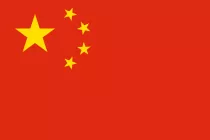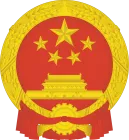China

Geographical Location of China
China extends over vast territories and, as a result, has great differences in climate and nature. In the north-west of the country, up to the border with Tajikistan, Kyrgyzstan and Mongolia, the landscape is characterized by large mountains and dry desert. In the more central parts of southeastern China we find a coastal landscape with fertile plains and tropical forests.
Most of China has a continental climate, but the southern and eastern parts of the country have a tropical climate with lots of rain. The continent's monsoon winds also have a major influence on China's climate, with polar winds from the north predominating in winter and warm and tropical winds blowing from the sea in summer.
China has the largest greenhouse gas emissions in the world, largely due to its extensive production and consumption of oil and coal. Industrial emissions have led to a shortage of clean drinking water and health problems among residents of several areas. Deforestation and soil erosion have caused China to lose a fifth of the country's arable land since 1949. More recently, they have begun to take environmental issues seriously and aim to stop further increases in greenhouse gas emissions by 2030.
Brief History of China
Chinese civilization is many thousands of years old. Broadly speaking, we can divide the history of China into three periods: early Chinese civilization until 221 BC, Imperial China from 221 BC. before 1911 and the Republic of China from 1911 to the present. During roughly separated periods, different dynasties and ruling families ruled. Among many dynasties, the Qin Dynasty (221-206 BC) stands out as unique. Chinese civilization has long been one of the most advanced in the world, and inventions such as the compass, gunpowder, paper and the art of printing came from China.
In 1644, the Qing dynasty came to power in the country, ruling until 1911. This period was characterized by stratification along ethnic lines, strong population growth due to innovations in technology and agriculture, and a more open foreign policy. In 1911, a revolution broke out, resulting in the founding of the Republic of China. The Nationalist Party of the Kuomintang and the Communist Party of China have been fighting for power for many years. After World War II, the struggle continued in the form of a bloody civil war. The communists, led by Mao Zedong, won the war and founded the People's Republic of China in 1949. Followers of the Nationalist Party left the mainland and settled on the Chinese island of Taiwan.
Mao ruled the country with an iron fist. His policies were characterized by close relations with the Soviet Union and rapid industrialization, which led to a famine that killed an estimated 20 million Chinese. Mao's death in 1976 led to a clash with the more radical elements of communism. The policies that followed in the decades after Mao's death fueled enormous economic growth while lifting millions of Chinese out of poverty.
Society and Politics of China
China is a socialist people's republic. The Communist Party has been in power since 1949 with no real opposition challenging it. The highest body of the state appoints the president and prime minister. Until the end of the year, the Congressional Executive Committee acts as a legislative assembly under the control of the Communist Party. Chinese President Xi Jinping came to power in 2013 and is considered the most powerful Chinese leader since Mao Zedong.
Previously, the one-child policy was implemented to limit population growth. This has led to fewer children, further complicating the challenges of an aging population. Chinese authorities maintain strict control over the population and have been criticized for human rights violations. Today, minority groups are discriminated against, including Uyghurs and other Muslim minorities. The media and the Internet are under control. Corruption is considered a widespread problem, and every year hundreds of people are sentenced to death for financial crimes.
China is a permanent member of the UN Security Council and the country is playing an increasingly important international role. In nearby regions, China wants to promote stability, cooperation and good trade relations. At the same time, China is trying, with varying degrees of success, to convince the outside world of its peaceful intentions.
Economy and Trade of China
Since 1970, China has moved from a centrally controlled planned economy to a more market-based economy of great international importance. Since the late 1970s, China has experienced enormous economic growth, making it one of the world's largest economies. Development has also created large differences between rich and poor and between urban and rural areas. Although a number of reforms have been introduced, the state still controls most of the economy. Considerations of social stability and economic growth guide Chinese policy.
China is rich in natural resources such as coal, oil and iron ore. The country has extensive trade with other countries and exports goods such as textiles, electronics, oil, automobiles and weapons. The country's most important trading partners are the EU, USA and Japan. Trade relations between the US and China have been very tense in recent years, with the countries imposing additional tariffs on each other's goods.
China requires a number of resources for its huge production. China has expanded its trade relations, which are important for both the country's imports and exports. Chinese investment abroad has increased significantly in recent years.
Chinese Cuisine and Culinary Traditions of China
Chinese cuisine is huge and varied, just like China itself. Considering the large size of the country, and most importantly, the heterogeneous composition of the population and the different raw material base, Chinese cuisine includes a wide variety of recipes, which are very different from each other both in the use of ingredients in them and in the methods of culinary processing of products. https://kashevar.com/en/recipes/china Chinese cuisine recipes common in northern China are radically different from southern or eastern Chinese dishes. Due to the fact that in China there are no religious or other prohibitions on eating various foods, Chinese cuisine uses almost everything that can be eaten as ingredients in dishes, which can sometimes shock tourists visiting China. But Chinese cuisine, which has long become popular in many countries around the world, also differs from the Chinese cuisine common in China itself - outside the country, Chinese dishes are adapted for European, American and other consumers. In foreign Chinese cuisine, more traditional for these regions are used as ingredients in dishes, in addition, the spiciness of the dishes is significantly reduced - this is characteristic not only of Chinese, but also of Indian and other national cuisines that have become widespread outside their countries.







